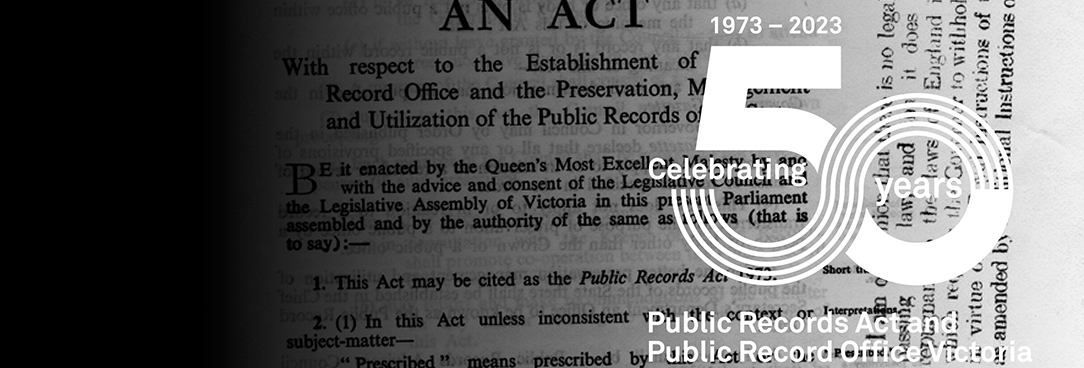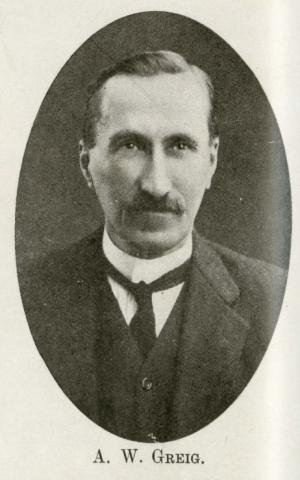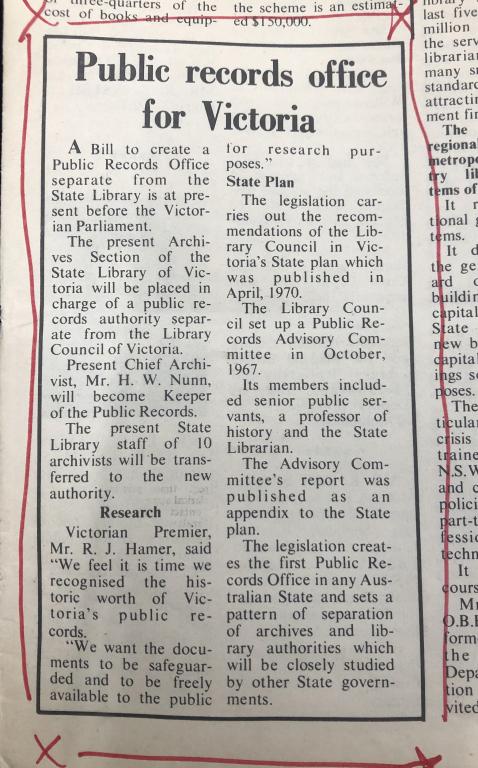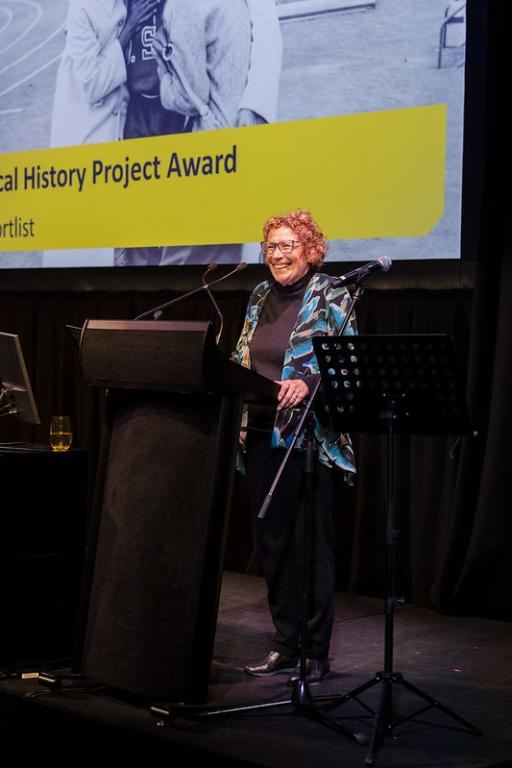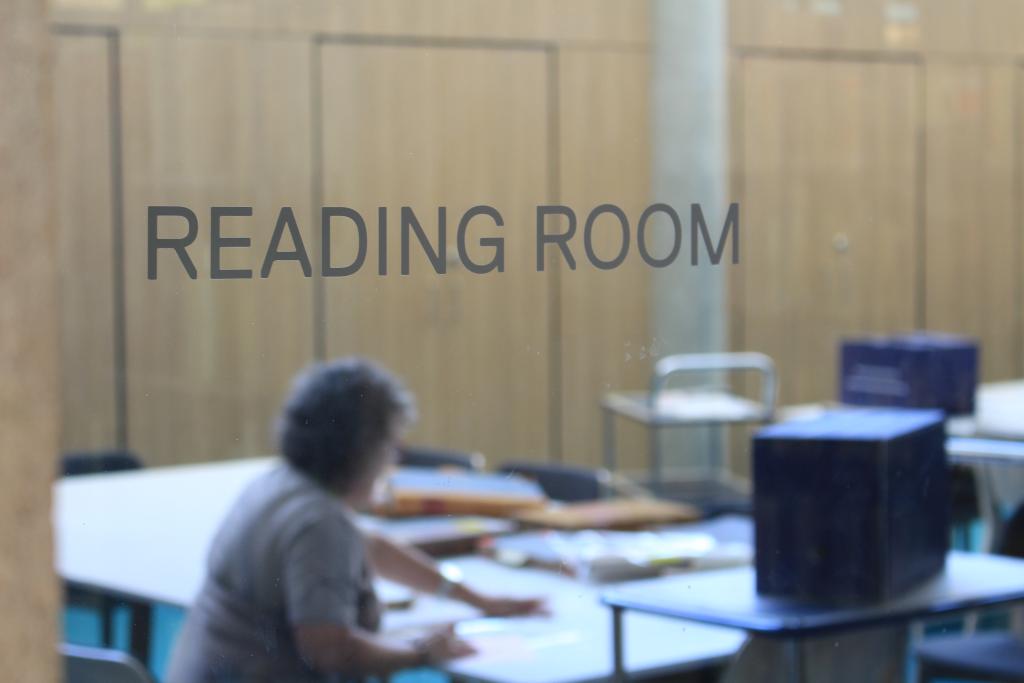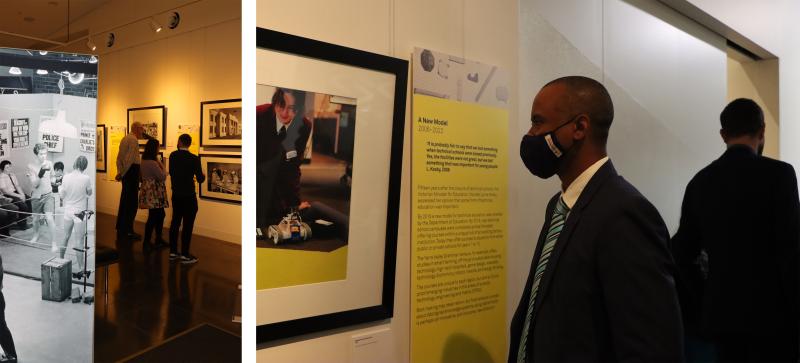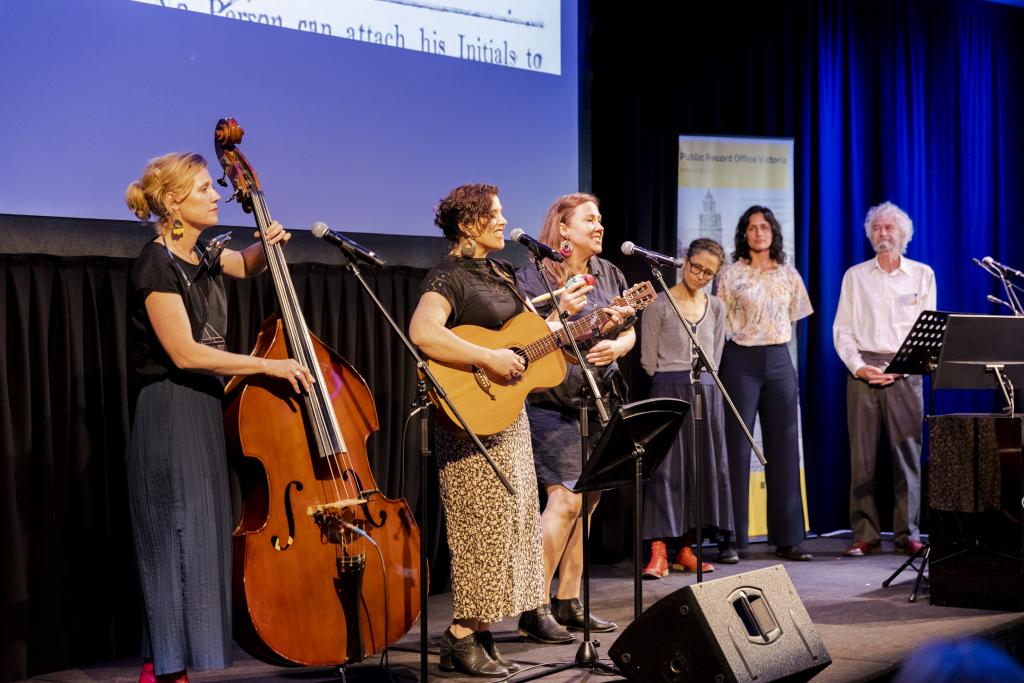
Author: Tara Oldfield
Senior Communications Advisor
The 17th of April 2023 marks the 50th anniversary of the passing of the Public Records Act 1973. The Act:
- established Public Record Office Victoria, the Keeper of Public Records, and the Public Records Advisory Council (PRAC)
- defined a public record, and the government entities to which the Act applied, including a definition of what constituted a public office
- granted the Keeper powers to establish recordkeeping standards and provide advice to agencies
- assigned heads of agencies the responsibility for records management in accordance with these standards as well as ensuring full and accurate records are made and kept
- and established provisions for the Minister to appoint places of deposit (PODs) which has allowed records of local significance to be housed in regional centres.
Fifty years later Public Record Office Victoria holds more than 100km of public records at the Victorian Archives Centre in North Melbourne under the leadership of the Keeper of Public Records and advice of PRAC; has a regional centre in Ballarat, and more than 100 appointed PODs across the State including at Bendigo and Geelong.
The archives pre-1973
The collection of what we now call Public Record Office Victoria began 120 years ago with ten battered, leather-bound copies of Convict Indents. The large books contained printed identities of the convicts who arrived in Sydney in the 1830s. The books were given to Melbourne Library Chief Librarian Ernest La Touche Armstrong by Mathew Byrne, Secretary to the Law Department of the Victorian Government.
In the book A Matter of Public Record, Professor Russell says:
“As Armstrong jotted down a note on the provenance of these books, so began the process of selecting and preserving the public records of Victoria.”
Prior to this 1903 handover, colonial record-keepers put in place comprehensive record systems beginning with the instructions to William Lonsdale to proceed to Port Phillip to establish government. The instructions were registered as inwards correspondence in Melbourne. Lonsdale’s record system evolved into the correspondence system of La Trobe. As other functions of government emerged, records were also kept by those relevant departments. In the meantime, the Public Library of Victoria began to house some public records of the State.
The Public Library and Royal Historical Society of Victoria
The first transfer of public records to the Public Library from a public office in Victoria occurred in 1903 with the ten volumes of the previously mentioned Convict Indents. Further volumes of the Indents followed as did various other public records. Armstrong in 1945 reflected:
“The Library has (now) obtained the custody of many state documents or public records, but no real attempt to establish a record office has yet been made.”
In 1909 the Royal Historical Society of Victoria was founded to collect and preserve reminiscences of old Colonists. One of the first issues pursued by the Society was the preservation of public records. The Age reported on an April 1910 meeting of the Society:
“The correspondence, he (Professor Ernest Scott) said, which passed during administration of the Port Phillip District by Latrobe from 1839 to 1854, between the Superintendent, as he was until 1848, and the ruling authorities, must have been considerable. It would deal with public administration, disposal of land, the gold discoveries, the attempted introduction of convicts and much else of value to the student of Colonial history. These documents were stored in the Lands Office, and a systematic study would reveal much interesting material. They should be sifted, arranged, and bound up in volumes and preserved after the manner adopted in the London Records Office. A resolution embodying Mr Scott’s suggestion was carried.”
In a meeting with the Premier, the Society’s Secretary Alfred Greig shared concerns of the destruction of public records and stated that “modern governments everywhere…are arranging for the preservation and collation of their official documents.”
While the Society was concerned with preserving historic records, a 1916-17 Royal Commission report into the public service recommended immediate destruction of ‘obsolete’ records. In A Matter of Record, Professor Russell states:
“The Royal Commissioners showed no awareness of the role of archives, and were focused on the issue of destroying obsolete records…During this period, some irreplaceable major record series were lost.”
But the Society was not deterred and continued discussions around safe preservation, ultimately advocating for continued transfer of records to the Public Library, as had begun in 1903. In 1922 the Library inspected records held at government offices and in 1923 the first transfer of local government records, those of the Melbourne City Council, took place. This was followed by transfers from the Chief Secretary’s and Public Works Departments.
After another inquiry into public service methods in 1927, the Society asked the Premier to advise that historical records no longer required by Departments should be offered to the Library first, rather than destroyed. The Premier agreed.
“No single administrative action was more significant than this for the future of Victorian archives during this period. As a result, the previous trickle of records towards the Library became a flood.” Twenty-five years later… “The Library found itself so inundated with records-in every spare corner-that the case for an archival solution had become irresistible.” A Matter of Public Record.
The Library’s first archivist, Donald William Archdall Baker, was soon appointed followed by Rosemary McGowan, then Patricia Ingham. In 1955, The Archives Division of the State Library would be created with the appointment of a new Senior Archivist and two archivists. A reflection of the times, recruitment sought men, even though the previous two archivists had been women:
“As the work is both dirty and at times heavy, the appointment of qualified men is to be preferred to female officers,” the Under-Secretary wrote to the Chairman of the Public Service, 5 November 1954.
The Archives Division of the State Library of Victoria ultimately ran from 1955 to 1973 under the leadership of Senior Archivist Harry Wilfred Nunn. It was Nunn, in 1961, who proposed the Public Records Act.
The role of archives and libraries
On 23 March 1961, Nunn wrote to the Under-Secretary asking that:
“consideration be given to the development of a central archives establishment which would provide adequate facilities…and that legislation should be enacted along the lines of the 1958 Public Records Act of Great Britain with suitable adaptations to suit Victorian conditions.”
The Jungwirth Inquiry of 1963-65 into library services in Victoria set the scene for debate about whether the archives should be separated from the Library as Nunn advocated. Historians petitioned for the separation, stating “contemporary thought is more and more in favour of the complete separation of archives from libraries, as their functions and methods differ radically.” Many other professionals and academics agreed. However, the campaign to retain the archives within the library was equally passionate, spearheaded by John Metcalfe (Librarian at the University of NSW), Sir Irving Benson (President of the Library Trustees and Minister of Wesley Church) and John Feely (Principal Librarian).
Ultimately the Inquiry Board fell on the side of separation. The Board also recommended that the head of archives should be called the Keeper of Public Records, and that matters pertaining to public records should be dealt with by legislation. The establishment of a Public Records Advisory Committee was also suggested. However, Benson was quick to campaign against these recommendations. Yet in 1967, Nunn forged ahead with the establishment of the Public Records Advisory Committee.
Public Records Advisory Committee
The Public Records Advisory Committee’s first meeting was held on the 21st of February 1969 at the Latrobe Library. Harry Nunn prepared the first agenda which included surveying legislation in other jurisdictions, suggested headings for Victorian legislation, and the issue of defining public records. By the end of that year, the Committee put forward a report reiterating the Jungwirth Inquiry’s recommendations including that a Public Record Office be established. They also advocated that definitions of public record, public offices and public officers should be adopted, that agencies should be responsible for ensuring complete and accurate records of their activities, and that public access should be allowed, among other recommendations.
Drafting the Bill
By 1970 a draft bill was in progress. The first draft was rejected by Nunn who spent Easter of 1972 rewriting. A third draft followed in May of that year. Of this version Nunn wrote to the State Librarian:
“As instructed by you I have not discussed this with members of the Archives staff, but make the following comment-the draft Bill is an excellent one carrying out the basic concepts and principles set out in the report of the Public Records Advisory Committee…It represents a first class restructuring of the previous draft bill (22/3/72) by creating a Public Record Office…while the draft Bill does not go as far as the Committee recommended in requiring record producing agencies to appoint an officer…whose purpose will be to facilitate the disposal of public records, it recognises the concept that records management is not an autonomous discipline.” He concluded the Bill was “sound, realistic, workable and flexible.”
The Bill was introduced into the Legislative Assembly by the Chief Secretary, ER Meagher, on 15 November, with the adjourned second reading debate resuming on the 30th. The Labor opposition was critical of the Bill and said they would not support it unless changes were made. Debate was adjourned again for four months in which time booksellers and collectors campaigned against the Bill. Among other issues, they were particularly concerned with the clause:
“Where a person has in his possession, other than as a public officer in the course of his duties, a public record worthy of permanent preservation, the Keeper of Public Records may by notice in writing require him to surrender the record to the Public Record Office.”
When debate resumed in March 1973, a letter of support for the Bill was provided by the Royal Historical Society of Victoria and the Hon Ian McLaren suggested changes to the clause booksellers were concerned with. Once amendments were made, the Bill was passed by the Legislative Assembly on 5 April 1973, and by the Legislative Council on 11 April with a further minor amendment. The Act was assented to and came into operation on 17 April 1973 and the Archives Division of the State Library became the Public Record Office.
Definitions of ‘public records’ and ‘public offices’
In the Act, a public record is defined as (i) any record made or received by a public officer in the course of his duties and (ii) any record made or received by a court or a person acting judicially in Victoria. The term was further defined as any document within the meaning of the Evidence Act 1958. Unlike the Commonwealth Archives Act, a public record under the Victorian Act does not include objects of archival significance.
The Act covers all Victorian public offices, defined as (i) any department, office or branch of the Government of Victoria; (ii) any public statutory body corporate or incorporated; (iii) any municipality or other body constituted by or under the Local Government Act 1958; or (iv) any other local governing body corporate or unincorporated.
Public Record Office Victoria and the Keeper
The key features of the Public Records Act were the establishment of Public Record Office Victoria, the Keeper of Public Records, and the Public Records Advisory Council (PRAC).
The Keeper of Public Records holds responsibility for the preservation, security and authentication of records under their control, the classification and accessibility of those records, and reproduction. The Keeper establishes standards for the management of public records, provides for the transfer of records to appointed Places of Deposit (PODs), and reports to the Minister responsible.
The first Keeper of Public Records was Harry Nunn. Since then, four more have followed.
- Harry Wilfred Nunn, Keeper from 17 April 1973 to 15 May 1981
- Christopher Hurley, 15 May 1981 to 5 October 1990
- Loretta Hambly, 5 October 1990 to 7 June 1991
- Clement Ross Gibbs, 10 June 1991 to 4 April 2003
- Justine Heazlewood, 7 April 2003 to present day.
By the time the Act was passed in 1973, there were around 24 kilometres of records, many unprocessed, across five State Library locations. There were few staff and not enough space. PROV’s first Keeper had his work cut out for him. On 10 May 1973 he sent a memo to the Under-Secretary with estimates for PROV as a separate office. He wanted 19 new positions but was given three at that time. He also sought separate accommodation from the Library, finally obtaining office space at 241 William Street in November 1974 and a storage building in Laverton in 1975.
The Laverton repository and search room was officially opened on 5 September 1978 by the Hon. RJ Hamer, then the Premier of Victoria. A continued supporter of the archives until his passing, we honour Hamer’s memory today through the Sir Rupert Hamer Records Management Awards.
Public Records Advisory Council
PRAC was established under the Act to provide advice to the Public Record Office and the Minister on administration of the Act and promote cooperation with other government agencies. Council members are appointed by the Minister.
The initial PRAC members consisted of government representatives, one historian and the State Librarian:
- Robert L King, Under-Secretary of the Chief Secretary’s Department
- Roy Glenister, Secretary to the Law Department
- Gordon Serpell, Director-General of the Public Works Department
- Ron Webster, Co-ordinator of Works at the Treasury
- Councillor LJ Howarth
- Professor Geoffrey Blainey
- Ken Horn, State Librarian
The inaugural meeting took place on the 12th of December 1973.
The Council today consists of a President, Judy Maddigan, and seven members covering a range of expertise with representatives for historical research (Prof Keir Reeves and Belinda Ensor), public administration (David Brous), finance and business administration (Deidre Missingham), Indigenous heritage (Bonnie Chew), local government (Steve Stefanopoulos OAM), and family history and genealogy (Diane Gardiner AM).
Places of deposit
Soon after the Public Records Act was passed, the Curator of the Burke Memorial Museum at Beechworth wrote to Nunn to request the Museum be allowed to take custody of local mining records held at the Court House. PROV staff visited the Museum days later and recommended the location as a suitable first place of deposit. It was the first POD appointed under the Act.
The Geelong Historical Records Centre (now the Geelong Heritage Centre within the Geelong Library and Heritage Centre) was opened in 1979 and made a POD in 1988. PROV’s Ballarat branch, the Ballarat Archives Centre, opened in 1982 and relocated to the Eureka Centre in 2019, and the Bendigo Regional Archives Centre arrived in 2008. Dr Michele Matthews, the Bendigo Regional Archives Centre’s first Archives Officer, wrote in 2012:
“The newly established Bendigo Regional Archives Centre (BRAC) had its genesis in the 1980s, when locals, including the editor of the Bendigo Advertiser and myself, argued that Bendigo needed to have its own archives centre (and museum) to house the region’s rich history dating back to the Victorian gold rush. The culmination of many local grassroots meetings was the establishment of BRAC in 2008 as a POD to care for permanent public records, as specified in the Victorian Public Records Act 1973.”
There are now more than 100 appointed PODs across Victoria, housing original records from local and state government agencies of importance to the local community.
The utilisation of public records
In the first ever Annual Report of the Keeper of Public Records for the year ended 30 June 1974, Harry Nunn wrote that in PROV’s first year, staff received 9841 inquiries and loaned out 1400 files to departments and public offices. He listed the lengthy research projects that staff assisted with:
- Soldier settlement after 1918
- Origin of town planning legislation in Victoria
- Medical practitioners on the goldfields
- History of the Chinese in Victoria
- History of the Victorian Police 1836-1910
- Aboriginal education in Victoria
- History of the Marine Board
- Biography of Frank Tate
- Migrant land settlement in Victoria in the 1920s
- A history of land settlement in Victoria
- A history of Western Wimmera
- A history of Litchfield – 100 years
- Poowong land settlement
- Effects of pressure groups on the development of technical education in Victoria.
Two years later, the VPRS system for classifying record series was implemented further improving records control and access.
Access was also at top of mind with the development of the current volunteer program in 1989 and the digitisation program in 2001. Today we have more than 70 volunteers dedicated to indexing, transcribing, re-packing and digitising records from the collection. These activities ensure records are more readily accessible to researchers.
In the 2021-22 financial year, we issued 29,728 public records to reading room visitors with an additional 3,768 records to government agencies. Many of the topics listed above as areas of interest in 1973 have also come back around in recent years. We hosted an exhibition about technical schools in 2022-23 and published WWI soldier settlement records online in 2015, both as part of state-wide anniversary projects.
Standards and strategies
The 1970s and 80s saw the development of disposal schedules for agencies, as well as the first PROV recordkeeping standards covering storage, disposition, transfer and disposal. A complete set of recordkeeping standards, specifications and guidelines were redeveloped with public offices between 2009-11 with a recent review of these concluding in 2021-22. Disposal schedules are today known as Retention and Disposal Authorities and are available from our website.
The first significant amendment of the Act was undertaken in 1986 to allow the Keeper the power to enter public offices and inspect records storage, conservation, and records management. The amendment was proclaimed on 18 October 1994.
The 1990s also saw government agencies begin the switch from paper to computers. To manage recordkeeping and transfers of the electronic records being created, in 1999 PROV produced the Victorian Electronic Records Strategy (VERS) providing agencies with a format and minimum set of metadata required for every electronic record of Government. To this day, VERS continues to ensure the creation, capture and preservation of authentic, complete and meaningful digital records by the Victorian public sector.
We launched our first digital archive in 2005, one of the first end-to-end digital archives in the world, updating it in 2021 as part of recent VERS work, replacing our entire archival management and digital preservation environment. This included transforming our online presence, ordering and warehouse management system in North Melbourne, with roll-out to Bendigo and Ballarat sites completed earlier this year.
Victorian Archives Centre
In addition to the agency records being transferred to PROV’s collection, privatisation and corporatisation of the 1990s also saw PROV absorb a significant number of major accessions, including the archives of the State Bank, Melbourne City Council, State Electricity Commission, Gas and Fuel Corporation, the Melbourne and Metropolitan Board of Works, and the Rural Water Commission. More space was needed.
A 1996 inquiry into the Public Record Office recommended a new purpose-built facility to be located less than 5km from the CBD, and so in 1998 it was announced a new archives building would be built on the former Government Printer and Gas and Fuel site in North Melbourne. A major project to design and build the Victorian Archives Centre, and then relocate from Laverton began. The building itself was officially opened to staff on 9 November 2000, with the Harry Nunn reading room opening to the public a few years later.
Senior Collections Advisor Charlie Farrugia remembers:
“The relocation of the collection occurred between July-October 2000 and involved moving 12.5 million files, 500,000 boxes or 1,760 truckloads of records. The meterage moved was estimated as 79,938m. The Reading Room at Casselden Place (known as the Melbourne Archives Centre) continued to operate until the Harry Nunn Reading Room at the VAC opened for the first time immediately after Easter in 2004. Prior to this, a temporary reading room was established on Level 1 at the VAC in what is now the Volunteer Room. This room opened on 10 October 2000. Both this temporary room and the Melbourne Archives Centre closed upon the opening of the VAC Reading Room.”
The Victorian Archives Centre now houses around 100kms of records dating from the start of government administration of the Port Phillip District in 1836 to the present day. The building receives visitors to the reading room, exhibitions in the VAC Gallery, and events in the conference room.
The building is also home to our friends at the National Archives of Australia with whom we have a long-standing partnership. When first opened, the Victorian Archives Centre was the only archival building in Australia where researchers could access both Commonwealth and state records in the one place.
Community
Engaging communities with the records of importance to them and assisting community groups and historians is another big part of what we do.
For more than 20 years our Local History Grants Program and Victorian Community History Awards (which we run in partnership with the Royal Historical Society of Victoria) have been funding and awarding history projects of significance by groups and individuals across Victoria. We also have a Koorie Records Unit and Reference Service run in collaboration with the National Archives of Australia to promote awareness about Aboriginal records within the collection and improve accessibility to Aboriginal communities.
For more than 10 years we have showcased records from our collection at exhibitions within the Old Treasury Building in a partnership that continues today. We also have a loan program that allows other museums the opportunity to showcase public records within their own exhibitions. And, in 2003, in time for the 30th anniversary of the Act, we launched our annual journal Provenance featuring peer-reviewed articles, as well as general research papers, drawing on original records from the collection. This year the journal celebrates its 20th year and 21st issue.
The final Act
The Public Records Act 1973 has ensured that records of Victoria’s past are kept, managed and preserved for generations to come. Public Record Office Victoria owes its existence to the Act and to those hard-working librarians, historians, archivists and politicians who fought for the Act’s creation and a place to store the public records of Victoria now and into the future.
A review of the Public Records Act is currently underway.
References/further reading:
- A Matter of Record: A History of Public Record Office Victoria, by Professor EW (Bill) Russell with original archival research by Charlie Farrugia, published 2003.
- A Happy Birthday from a Long-Standing Staff Member, blog by Charlie Farrugia, published 2020.
- Celebrating 20 years of the Victorian Archives Centre, blog by Tara Oldfield, published 2020.
- New History From Below, article by Dr Michele Matthews, published 2021.
Thank you Charlie Farrugia for assisting with this article.
Material in the Public Record Office Victoria archival collection contains words and descriptions that reflect attitudes and government policies at different times which may be insensitive and upsetting
Aboriginal and Torres Strait Islander Peoples should be aware the collection and website may contain images, voices and names of deceased persons.
PROV provides advice to researchers wishing to access, publish or re-use records about Aboriginal Peoples
